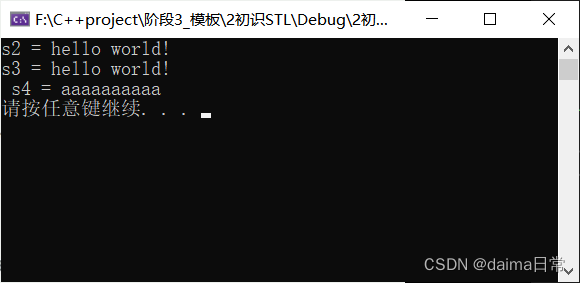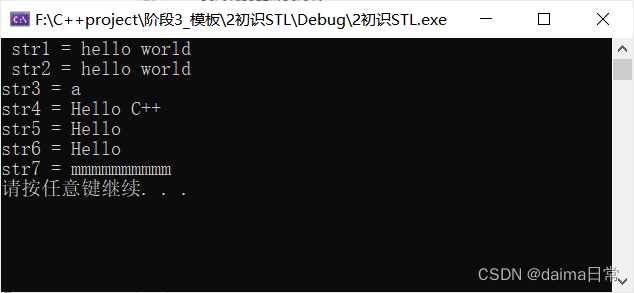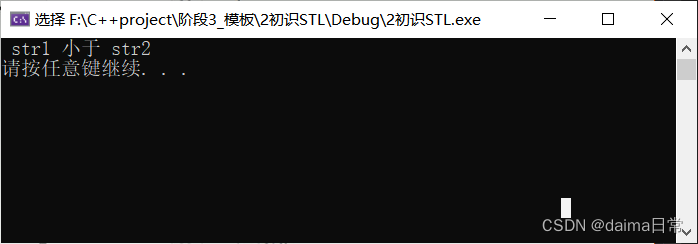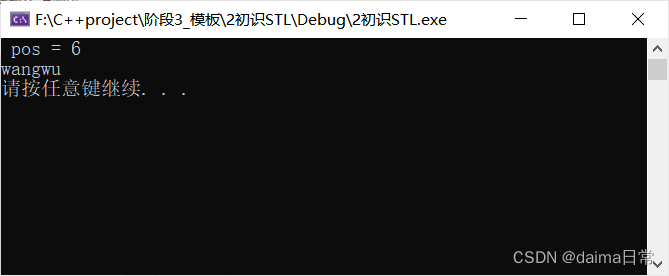文章目录
12 STL-常用容器
12.1 string 容器
12.1.1 string基本概念
本质:
- string是C++风格的字符串,而string本质上是一个类
*string和char 区别:
- char *是一个指针
- string是一个类,类内部封装了char ,管理这个字符串,是一个char型容器。
特点:
string类内部封装了很多成员方法
例如:查找find、拷贝copy、删除delete替换replace、插入insert
string管理char* 所分配的内存,不用担心复制越界和取值越界等,由类内部进行负责。
12.1.2 string构造函数
- string(); //创建一个空的字符串 例如:string str;
- string(const char* s); //使用字符串s初始化
- string(const string& str); //使用一个string对象初始化另一个string对象
- string(int n, char c); //使用n个字符c初始化
示例代码:
#include<iostream>
using namespace std;
//#include<string>
/*
- string(); //创建一个空的字符串 例如:string str;
- string(const char* s); //使用字符串s初始化
- string(const string& str); //使用一个string对象初始化另一个string对象
- string(int n, char c); //使用n个字符c初始化
*/
void test41()
{
string s1; //默认构造
const char* str = "hello world!";
string s2(str);
cout << "s2 = " << s2 << endl;
//拷贝构造
string s3(s2);
cout << "s3 = " << s3 << endl;
//tring(int n, char c); //使用n个字符c初始化
string s4(10,'a');
cout << " s4 = " << s4 << endl;
}
int main()
{
test41();
system("pause");
return 0;
}
运行结果:

总结:string的多种构造方式没有可比性,灵活使用即可。
12.1.3 string赋值操作
功能描述:
- 给string字符串进行赋值
赋值的函数原型:
- string& operator=(const char* s); //char*类型字符串赋值给当前的字符串
- string& operator=(const string &s); //把字符串s赋给当前的字符串
- string& operator=(char c); //字符赋值给当前的字符串
- string& assign(const char *s); //把字符串s赋给当前的字符串
- string& assign(const char *s, int n); //把字符串s的前n个字符赋给当前的字符串
- string& assign(const string &s); //把字符串s赋给当前字符串
- string& assign(int n, char c); //用n个字符c赋给当前字符串
示例代码:
#include<iostream>
using namespace std;
#include<string>
/*
*string赋值操作
1. string& operator=(const char* s); //char*类型字符串赋值给当前的字符串
2. string& operator=(const string &s); //把字符串s赋给当前的字符串
3. string& operator=(char c); //字符赋值给当前的字符串
4. string& assign(const char *s); //把字符串s赋给当前的字符串
5. string& assign(const char *s, int n); //把字符串s的前n个字符赋给当前的字符串
6. string& assign(const string &s); //把字符串s赋给当前字符串
7. string& assign(int n, char c); //用n个字符c赋给当前字符串
*/
void test51()
{
string str1;
str1 = "hello world";
cout << " str1 = " << str1 << endl;
string str2 = str1;
cout << " str2 = " << str2 << endl;
string str3;
str3 = 'a';
cout << "str3 = " << str3 << endl;
string str4;
str4.assign("Hello C++");
cout << "str4 = " << str4 << endl;
string str5;
str5.assign("Hello C++", 5);
cout << "str5 = " << str5 << endl;
string str6;
str6.assign(str5);
cout << "str6 = " << str6 << endl;
string str7;
str7.assign(10, 'm');
cout << "str7 = " << str7 << endl;
}
int main()
{
test51();
system("pause");
return 0;
}
运行结果:

**总结:**string的赋值方式有很多,operator=这种方式是比较实用的。
12.1.4 string字符串拼接操作
功能描述:
- 实现在字符串末尾拼接字符串
函数原型:
- string& operator+=(const char* str); //重载+=操作符
- string& operator+=(const char c); //重载+=操作符
- string& operator+=(const string& str); //重载+=操作符
- string& append(const char *s); //把字符串s连接到当前字符串结尾
- string& append(const char *s,int n); //把字符串s的前n个字符连接到当前字符串结尾。
- string& append(const string &s); //同operator+=(const string& str)
- string& append(const string &s,innt pos,int n);//字符串s中从pos开始的n个字符连接到字符串结尾。
示例代码:
#include<iostream>
using namespace std;
#include<string>
/*
**函数原型**:
- string& operator+=(const char* str); //重载+=操作符
- string& operator+=(const char c); //重载+=操作符
- string& operator+=(const string& str); //重载+=操作符
- string& append(const char *s); //把字符串s连接到当前字符串结尾
- string& append(const char *s,int n); //把字符串s的前n个字符连接到当前字符串结尾。
- string& append(const string &s); //同operator+=(const string& str)
- string& append(const string &s,innt pos,int n);//字符串s中从pos开始的n个字符连接到字符串结尾。
*/
void test61()
{
string str1 = "我";
str1 += "爱学习";
cout << " str1 = " << str1 << endl;
str1 += ":";
cout << " str1 = " << str1 << endl;
string str2 = " 敲代码、看书 ";
str1 += str2;
cout << " str1 = " << str1 << endl;
string str3 = "I";
str3.append(" love");
cout << " str3 = " << str3 << endl;
str3.append(" study much",6);
cout << " str3 = " << str3 << endl;
//str3.append(str2);
//cout << " str3 = " << str3 << endl;
str3.append(str2, 6, 4);//参数2从那个位置开始借取,参数3截取的长度
cout << " str3 = " << str3 << endl;
}
int main()
{
test61();
system("pause");
return 0;
}
运行结果:

总结:字符串拼接操作比较多,初学阶段只需要记住几种即可。
12.1.5 string查找和替换
功能描述:
- 查找:查找指定字符串是否存在
- 替换:在指定的位置替换字符串
函数原型:
int find(const string& str, int pos = 0) const;//查找str第一次出现位置,从pos开始查找int find(const char* s, int pos = 0) const;//查找s第一次出现位置,从pos开始查找int find(const char* s, int pos, int n) const;//从pos位置查找s的前n个字符第一次位置int find(const char c, int pos = 0) const;//查找字符c第一次出现位置int rfind(const string& str, int pos = npos) const;//查找str最后一次位置,从pos开始查找int rfind(const char* s, int pos = npos) const;//查找s最后一次出现位置,从pos开始查找int rfind(const char* s, int pos, int n) const;//从pos查找s的前n个字符最后一次位置int rfind(const char c, int pos = 0) const;//查找字符c最后一次出现位置string& replace(int pos, int n, const string& str);//替换从pos开始n个字符为字符串strstring& replace(int pos, int n,const char* s);//替换从pos开始的n个字符为字符串s
示例代码:
#include<iostream>
using namespace std;
#include<string>
//字符串查找和替换
//1、查找
void test71()
{
string str1 = "abcdefgh";
int pos = str1.find("de"); //从0开始计数,没有找到返回-1
if (pos==-1)
{
cout << "未找到字符串" << endl;
}
else
{
cout << "找到字符串, pos = " << pos << endl;
}
//rfind和find区别
//rfind从右往左查找,find从左往右查找
pos = str1.rfind("de");
cout << " pos = " << pos << endl;
}
//2、替换
void test72()
{
string str1 = "abcdefg";
str1.replace(1, 3, "8888");
cout << " str1 = " << str1 << endl;
}
int main()
{
//test71();
test72();
system("pause");
return 0;
}
运行结果:

总结:
- find查找是从左往右,rfind是从右往左
- find查找字符串后返回查找的第一个字符位置,找不到返回-1
- replate在替换时,要指定从哪个位置起,多少个字符,替换成什么样的字符串。
12.1.6 string字符串比较
功能描述:
- 字符串之间的比较
比较方式:
- 字符串比较是按字符的ASCII码进行对比
= 返回 0
> 返回 1
< 返回 -1
函数原型:
- int compare(const &s)const; //与字符串s比较
- int compare(const char *s); //与字符串s比较
示例代码:
#include<iostream>
using namespace std;
//字符串比较
void test81()
{
string str1 = "hella";
string str2 = "hello";
int ret = str1.compare(str2);
if (ret==0)
{
cout << "str1等于str2" << endl;
}
else if(ret > 0)
{
cout << " str1 大于 str2" << endl;
}
else
{
cout << " str1 小于 str2" << endl;
}
}
int main()
{
test81();
system("pause");
return 0;
}
运行结果:

总结:字符串对比主要是用于比较两个字符串是否相等,判断谁大谁小的意义不大。
12.1.7 string字符存取
string中单个字符存取方式有两种:
- char& operator[](int n); //通过[]方式存取字符
- char& at(int n); //通过at方式获取字符
示例代码:
#include<iostream>
using namespace std;
#include<string>
//string 字符存取
void test91()
{
string str = "hello";
//cout << " str = " << str << endl;
for (int i = 0; i < str.size(); i++)
{
cout << str[i] << " ";
}
cout << endl;
//2、通过at方式访问单个字符
for (int i = 0; i < str.size(); i++)
{
cout << str.at(i) << " ";
}
cout << endl;
//修改单个字符
//hello -> xello
str[0] = 'x';
cout << " str = " << str << endl;
str.at(1) = 'x';
//xxllo
cout << " str = " << str << endl;
}
int main()
{
test91();
system("pause");
return 0;
}
运行结果:

总结:string字符串中单个字符存取有两种方式,利用[]或者at
12.1.8 string插入和删除
功能描述:
- 对string字符串进行插入和删除字符操作
函数原型:
- string& insert(int pos,const char* s); //插入字符串
- string& insert(int pos,const string& str);//插入字符串
- string& insert(int pos,int n,char c); //在指定位置插入n个字符c
- string& erase(int pos, int n=npos); //删除从pos开始的n个字符
示例代码:
#include<iostream>
using namespace std;
/*
* string 插入和删除
- string& insert(int pos,const char* s); //插入字符串
- string& insert(int pos,const string& str);//插入字符串
- string& insert(int pos,int n,char c); //在指定位置插入n个字符c
- string& erase(int pos, int n=npos); //删除从pos开始的n个字符
*/
//字符串 插入和删除
void test101()
{
string str = "hello";
//插入
str.insert(1, "888");
//h888ello
cout << " str = " << str << endl;
//删除
str.erase(1, 3);
cout << " str = " << str << endl;
}
int main()
{
test101();
system("pause");
return 0;
}
运行结果:

总结:插入和删除的起始下标都是从0开始的
12.1.9 string子串
功能描述:
- 从字符中获取想要的子串
函数模型:
- string substr(int pos = 0,int n = npos)const; //返回由pos开始的n个字符组成的字符串。
示例代码:
#include<iostream>
using namespace std;
//string求子串
void test111()
{
string str1 = "abcdefgh";
string subStr = str1.substr(1, 3);
cout << " subStr = " << subStr << endl;
}
//实操
void test112()
{
string email = "wangwu@sina.com";
//从邮件地址中 获取 用户名信息
int pos = email.find("@");
cout << " pos = " << pos << endl;
string usrName = email.substr(0,pos);
cout << usrName << endl;
}
int main()
{
//test111();
test112();
system("pause");
return 0;
}
运行结果:

总结:灵活的运用子串功能,可以在实际开发中获取有效的信息。
码字不容易,谢谢你的点赞,评论和转发 ( ^ o ^)/~。






















 690
690











 被折叠的 条评论
为什么被折叠?
被折叠的 条评论
为什么被折叠?








